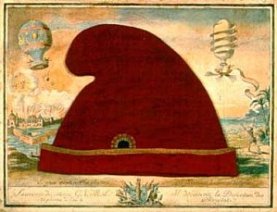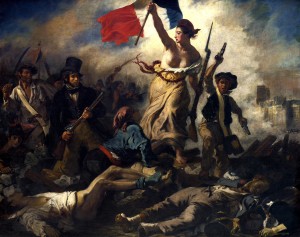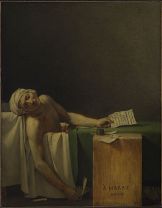Originally posted at gargarean.wordpress.com15 July 14
 My dreams are pretty unreal, sometimes they are extremely violent, sometimes they are enlightening. Maybe that’s why I earned the title of ὀνειρομαιήτωρ – seeker of dreams – from Dionysus?
My dreams are pretty unreal, sometimes they are extremely violent, sometimes they are enlightening. Maybe that’s why I earned the title of ὀνειρομαιήτωρ – seeker of dreams – from Dionysus?
A dream I want to focus on was very visual as it instructed me to respect Bastille day with a theme of Dionysos Lyaios “Dionysos the Liberator.” Strange that an Australian with no French links would be reminded of the national day of France… Admittedly, I do have some knowledge of this event as I studied both the American and French revolution in high school, but this is the first time I have thought about it since. I awoke around 4am on the 12th of July after living through the smoky storming of the Bastille, witnessing pitchfork wielding peasants and troops firing hopelessly at the raging masses that tore the guards apart like Agave verses Pentheus.
For a brief, simplified history lesson: 1789 France was facing crisis with a poor investment in hundreds of years of war, enlightened common people, drought and famine, debt from the previous kings extravagance, corrupt tax collectors who enforced heavy taxation and a disconnected and literally impotent king. The country was in the shits. King Louis XVI ordered a General Assembly that involved the nobles, religious leaders and common men to help negotiate and resolve these problems, however after the bourgeois (the commons) expressed their discontent of the current regime they were expelled from the assembly. In political terms they revolted and held an unofficial meeting in a tennis court and wrote the Tennis Court Oath – a statement that ordered the old regime to establish a constitution. When word arrived in Paris that the representatives of the common people were expelled from the meeting the people revolted and stormed a building that was symbolic of the authority, the Bastille.
The Bastille was a twelfth century fort once used to defend Paris but had since been converted into a royal prison. In 1789 it was rarely used as an actual prison – at the time of storming only eight prisoners were in it – but as a symbol the Bastille represented the ultimate fear of the common people. On the 14th of July the tension between classes built up to boiling point and peasants armed themselves and stormed the fort. Thereafter starting a chain of events that would become the French Revolution.
The French Revolution is a fascinating subject, one that I adore, because unlike the previous revolutions like the English and American, the French decorated their history with fantastic tales. They had a dramatic passion of theatre and illustrated it by creating elaborate fables of violence and sex. In some ways I see many instances of Euripides’ Bacchae being enacted in their stories, such as, the women marches on the Palace of Versailles for the queens head (many were men crossed dressed) then the dismemberment of a king that many actually ‘liked’ and only served as the continuation of the endless falling guillotine. Tales of nobles and priest being torn limb from limb by a rampaging mobs. The macabre and sick pleasure of violence seen in the Reign of Terror… and then the use of classical symbols.
 The Phrygian cap is one symbol, the red cap is iconic of the sans-culottes (lower class militia) but predates the revolution. The cap goes back to antiquity and has always been a symbol of liberation and the east. It is associated with the gods, Attis and Mithas – both connected to Dionysus. It is also associated with the Trojans, with Paris often wearing the cap in classical art. In Roman times freed slaves wore the cap to designate themselves from other slaves.
The Phrygian cap is one symbol, the red cap is iconic of the sans-culottes (lower class militia) but predates the revolution. The cap goes back to antiquity and has always been a symbol of liberation and the east. It is associated with the gods, Attis and Mithas – both connected to Dionysus. It is also associated with the Trojans, with Paris often wearing the cap in classical art. In Roman times freed slaves wore the cap to designate themselves from other slaves.
I’m not sure of the exact reason for adoption in the French Revolution but suspect it’s due to continue use in Europe to symbolise freedom. I recall a fable by my history teacher told me about how the cap earned its colour he said, women would knit them in white wool in between executions and when the main event would come to climax they’d dye the hats in the blood from those slain… nice.
Most likely fantasy but that’s all part of it isn’t it?
Marianne is the personification of Liberty and reason. She is usually depicted wearing the Phrygian cap holding a spear or fasces, often with one breast exposed. The exposed breast is an interesting symbol that goes back to the Acropolis marbles of the Amazonomachy. Typically it represents dual sex or sexual equality, also both strength and weakness. In myth it is said that Amazons removed one of their breasts so it does not get in the way of firing bows, such depictions in Greek art would break the rules of aesthetics so artists opted to have one breast exposed while the other is covered. In this sense the Amazons were trans-sex. The Amazonomachy itself is considered a symbol of Athens triumph over the Persians, what better way to insult your enemies than make them girls?
Back to the Phrygian cap, Attis is a transsexual god known to been castrated, usually by himself in madness or by Dionysus. Marianne wearing the cap again reinforces that, while Marianne is female she is taking a dual sex role as liberty is a universal right.
King Louis XIV directly identified himself with Apollo as the Sun King. The Palace of Versailles was his dream, a magical wonderland completely disconnected from the rest of France set out in a manner that honours Apollo and classism. Louis XIV’s extravagance was one of the contributors to the insane debt the nation was generating, a debt that his dim-witted and sheltered grandson inherited. This kind of story always reminds me of King Midas. After doing a favour for Dionysus, Midas is given one wish: he requests the ability to turn everything into gold. Midas happily spends his day turning his roses gold, until he sits at the dinner table grasping at his food only to find it turned to gold. Frightened he hugs his daughter for comfort and turns her to gold. The king is overtaken by grief and self-realisation of his greed and asks for his blessed curse to be remove. Midas eventually cures himself, but thereafter becomes an ascetic, living a life as a wild man. During the revolution the common people out right rejected the old fashion and followed Midas, there are some humorous scenes were judges would cover themselves in mud or dust, wear labours clothing just to prove their disconnection from the Old Regime, thus able to pass judgement.
 Revolutionaries also twisted classical symbolism back on itself to justify their actions. In art terms this was the starting place of Neo-Classism, with artists like Jacques-Louis David using classical themes and subjects for political paintings. Idealised Athens was a birthplace of reason, democracy and the Republic. With these concepts in mind this is also the birth of realism. David’s painting “The Death of Marat” became a religious icon of the Jacobin’s who would reproduce the image and place in churches instead of Christ. However it’s realism is quite startling to me and was a revolution in its conception.
Revolutionaries also twisted classical symbolism back on itself to justify their actions. In art terms this was the starting place of Neo-Classism, with artists like Jacques-Louis David using classical themes and subjects for political paintings. Idealised Athens was a birthplace of reason, democracy and the Republic. With these concepts in mind this is also the birth of realism. David’s painting “The Death of Marat” became a religious icon of the Jacobin’s who would reproduce the image and place in churches instead of Christ. However it’s realism is quite startling to me and was a revolution in its conception.
This tradition continued with the raise of Napoleon who styled himself after Caesar and as he sort to bring an end to the chaos of revolution. In some instants he removed much of the Jacobin influences and re-established laws from the old regime. Napoleon’s influences on Europe is messy business but his legacy continues to remain in Europe today. The French revolution was the starting place of the modern world, it was like the terrible death of Dionysus only to be reborn anew and better.
The privileges that many take for granted were born from the blood of the French Revolution and why I think it a worthy holiday for Dionysos Lyaios.
Images all sourced from Wikipedia under Public Domain.
Markos Gage (The Gargarean) — an Australian, Dionysian – Hellenic polytheist artist and writer.
Personal blog
Art website
Facebook
Email: markus.gage85 at gmail .com